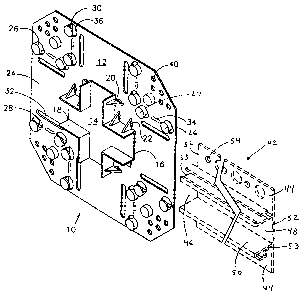Une partie des informations de ce site Web a été fournie par des sources externes. Le gouvernement du Canada n'assume aucune responsabilité concernant la précision, l'actualité ou la fiabilité des informations fournies par les sources externes. Les utilisateurs qui désirent employer cette information devraient consulter directement la source des informations. Le contenu fourni par les sources externes n'est pas assujetti aux exigences sur les langues officielles, la protection des renseignements personnels et l'accessibilité.
L'apparition de différences dans le texte et l'image des Revendications et de l'Abrégé dépend du moment auquel le document est publié. Les textes des Revendications et de l'Abrégé sont affichés :
| (12) Brevet: | (11) CA 2151185 |
|---|---|
| (54) Titre français: | JOINT PREFABRIQUE POUR TABLEAU DE BAIE |
| (54) Titre anglais: | PREFABRICATED REVEAL JOINT |
| Statut: | Durée expirée - au-delà du délai suivant l'octroi |
| (51) Classification internationale des brevets (CIB): |
|
|---|---|
| (72) Inventeurs : |
|
| (73) Titulaires : |
|
| (71) Demandeurs : |
|
| (74) Agent: | GOWLING WLG (CANADA) LLP |
| (74) Co-agent: | |
| (45) Délivré: | 2005-08-02 |
| (22) Date de dépôt: | 1995-06-07 |
| (41) Mise à la disponibilité du public: | 1995-12-16 |
| Requête d'examen: | 2002-04-08 |
| Licence disponible: | S.O. |
| Cédé au domaine public: | S.O. |
| (25) Langue des documents déposés: | Anglais |
| Traité de coopération en matière de brevets (PCT): | Non |
|---|
| (30) Données de priorité de la demande: | ||||||
|---|---|---|---|---|---|---|
|
Un ensemble de joint préfabriqué moulé d'une seule pièce de plastique et utilisé pour raccorder des canaux décoratifs ou tableaux de baie sur l'extérieur des bâtiments. Les tableaux de baie sont généralement utilisés pour former un effet esthétiquement agréable sur la surface extérieure d'un bâtiment qui est recouverte de stuc, mortier, ciment, plâtre, placoplâtre ou similaire. Cette invention offre un joint relativement peu coûteux qui simplifie grandement le travail de jointure des tableaux de baie sur les chantiers.
A prefabricated joint assembly molded of a single piece of plastic and used for connecting decorative channels or reveals on the exteriors of buildings. Reveals are typically used to form an aesthetically pleasing effect on the exterior surface of a building that will be covered with stucco, mortar, cement, plaster, drywall, or the like. This invention provides a relatively inexpensive joint that vastly simplifies the job of joining reveals at the construction site.
Note : Les revendications sont présentées dans la langue officielle dans laquelle elles ont été soumises.
Note : Les descriptions sont présentées dans la langue officielle dans laquelle elles ont été soumises.

2024-08-01 : Dans le cadre de la transition vers les Brevets de nouvelle génération (BNG), la base de données sur les brevets canadiens (BDBC) contient désormais un Historique d'événement plus détaillé, qui reproduit le Journal des événements de notre nouvelle solution interne.
Veuillez noter que les événements débutant par « Inactive : » se réfèrent à des événements qui ne sont plus utilisés dans notre nouvelle solution interne.
Pour une meilleure compréhension de l'état de la demande ou brevet qui figure sur cette page, la rubrique Mise en garde , et les descriptions de Brevet , Historique d'événement , Taxes périodiques et Historique des paiements devraient être consultées.
| Description | Date |
|---|---|
| Inactive : Périmé (brevet - nouvelle loi) | 2015-06-07 |
| Inactive : CIB de MCD | 2006-03-11 |
| Accordé par délivrance | 2005-08-02 |
| Inactive : Page couverture publiée | 2005-08-01 |
| Inactive : Grandeur de l'entité changée | 2005-05-26 |
| Inactive : Taxe finale reçue | 2005-05-18 |
| Préoctroi | 2005-05-18 |
| Un avis d'acceptation est envoyé | 2005-03-10 |
| Un avis d'acceptation est envoyé | 2005-03-10 |
| Lettre envoyée | 2005-03-10 |
| Inactive : Approuvée aux fins d'acceptation (AFA) | 2005-02-25 |
| Lettre envoyée | 2002-05-02 |
| Inactive : Renseign. sur l'état - Complets dès date d'ent. journ. | 2002-05-02 |
| Inactive : Dem. traitée sur TS dès date d'ent. journal | 2002-05-02 |
| Toutes les exigences pour l'examen - jugée conforme | 2002-04-08 |
| Exigences pour une requête d'examen - jugée conforme | 2002-04-08 |
| Demande publiée (accessible au public) | 1995-12-16 |
Il n'y a pas d'historique d'abandonnement
Le dernier paiement a été reçu le 2005-05-18
Avis : Si le paiement en totalité n'a pas été reçu au plus tard à la date indiquée, une taxe supplémentaire peut être imposée, soit une des taxes suivantes :
Les taxes sur les brevets sont ajustées au 1er janvier de chaque année. Les montants ci-dessus sont les montants actuels s'ils sont reçus au plus tard le 31 décembre de l'année en cours.
Veuillez vous référer à la page web des
taxes sur les brevets
de l'OPIC pour voir tous les montants actuels des taxes.
Les titulaires actuels et antérieures au dossier sont affichés en ordre alphabétique.
| Titulaires actuels au dossier |
|---|
| PLASTIC COMPONENTS, INC. |
| Titulaires antérieures au dossier |
|---|
| THOMAS J. GRETZ |
| THOMAS S. STARK |